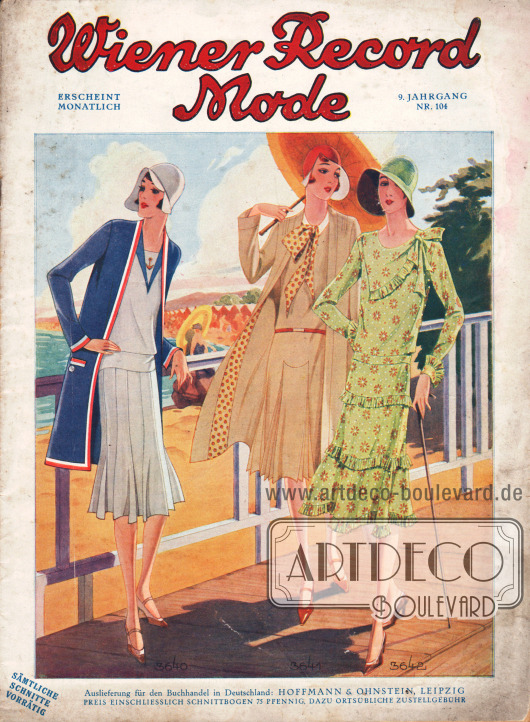|
P. 1 |
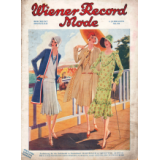
|
Front page, title page or cover of the Austrian illustrated women's and fashion magazine Wiener Record Mode (Eng. title: Viennese Record Fashion) no. 104 for July 1929.
PUBLISHED MONTHLY.
9TH VOLUME, NO. 104.
DESCRIPTION OF THE MODELS ON THE FIRST COVER PAGE:
3640. Chic midsummer ensemble. Novelty pleated skirt and jumper in white linen. ⅞ length, strictly straight jacket in blue linen, with red and white trim. (Fabric usage: white linen 3.60 m by 80 cm width, blue linen 2.30 m by 80 cm width. Pattern size 44.)
3641. Elegant coat ensemble for midsummer. The material used is natural shantung silk. Finery and artist's tie made of large spotted foulard. Turn-down collar made of lingerie cloth. Leather belt. (Fabric usage: shantung 6 m by 90 cm width, foulard 0.30 m by 90 cm width. Pattern size 44.)
3642. Filmy midsummer dress made of colorful patterned crepe de chine, in a simple shape. Three-tiered skirt with pleated ruffles. Fancy ascot tie-effect with pleated frills and bow made of the same material. (Fabric usage: crepe de chine patterned 4.25 m by 100 cm width. Pattern size 44).
ALL PATTERNS IN STOCK.
Delivery for the book trade in Germany: HOFFMANN & OHNSTEIN, LEIPZIG.
PRICE INCLUDING PATTERN SHEET 75 PFENNIGS, PLUS LOCAL DELIVERY CHARGE.
Drawing/illustration: unknown/unsigned.
[Page 1]
|
|
P. 2 |
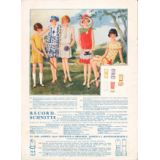
|
3643. Girls' dress made of linen in a bloused, belted style with rich quilting decoration. (Fabric usage: linen 2 m by 80 cm width. Pattern size 8—10 years.)
3644. Girl's dress made of patterned foulard with sleeveless jacket. Front made of plain-colored foulard in the color of the pattern. Lingerie collar and vestee insert. (Fabric usage: patterned foulard 3.25 m by 90 cm width, plain foulard 0.50 m by 90 cm width, lingerie 0.40 m by 90 cm width. Pattern size 10—12 years).
3645. Filmy little girl's dress made of marquisette in simple style with decoration of ajour cutwork. (Fabric usage: marquisette 2 m by 100 cm width. Pattern size 8—10 years.)
3646. Lovely little girl's dress. Collar, vestee insert and pleated skirt made of white linen. Jumper and skirt bottom in pastel pink linen. Apache fichu made of spotted foulard. (Fabric usage: white linen 1.25 m by 80 cm width, pastel pink linen 1.75 m by 80 cm width, spotted foulard 0.75 m by 90 cm width. Pattern size 10—12 years).
3647. Girls' dress in pretty patterned etamine fabric. The bertha collar and the flounces are scalloped. (Fabric usage: etamine 2.75 m by 100 cm width, pattern size 10—12 years).
RECORD PATTERNS for all styles are available for immediate delivery in the indicated standard sizes with pictures and descriptions on the individual pattern pieces at the following prices:
Large patterns GM. 1.— (dress, costume, coat).
Small patterns GM. —.70 (skirt, blouse, children's dress)
Patterns made to measure GM. 4.— (complicated patterns 50% surcharge).
The cheapest way to order by mail is to pay the amount and GM. —.15 for postage to a postal check account, note the order on the section of the same, or advance mailing in stamps, plus GM. —.15 postage. For cash on delivery there is an additional charge of GM. —.30.
Prices of the transfers for our needlework patterns: Size I GM. —.75, size II GM. 1.30, size III GM. 1.80.
Pattern stock in the following cities, available through record pattern sales office in:
Brunswick, Bohlweg 49, Heinrich Boennighausen.
Breslau, I. Bluecherplatz 20/I, Heinrich Diegmann, telephone: Ohle 7624.
Dessau, theater building, Joh. Rothe.
Dresden-A., Wallstrasse 12, Alwin Krause.
Elberfeld, Wallstrasse, Ph. Freudenberg.
Frankfurt a. M., Goethestrasse 27/1, J. & M. Martens.
Freiberg, Erbische Str. 2—4, Carl Hubricht.
Halle a. Saale, Gr. Ulrichstrasse 6—8, W. F. Wollmer.
Hamburg, Heuberg 1, B. Meyer.
Hanover, Karmarschstrasse 5, C. Westermann.
Hirschberg, Adolf Staeckel & Co.
Kassel, Oberste Gasse 28, A. Waege.
Kiel, Knooperweg 22, C. Fries.
Cologne a. Rhine, Glockengasse 13, Heinr. Kramer.
Leipzig C 1, Hospitalstrasse 2, Hoffmann & Ohnstein, telephone 10890.
Magdeburg, Schuhbruecke 10, Hans Kaufmann.
Mainz, Mittlere Bleiche 41, F. Schaudt.
Munich, Utzschneiderstrasse 9, H. Staudinger, telephone 20483.
Nuremberg, Adlerstrasse 14, F. Lengenfelder.
Where not available: through HOFFMANN & OHNSTEIN, LEIPZIG C 1, HOSPITALSTRASSE 2. Postal check account Leipzig no. 52.923.
[Page 2]
|
|
P. 3 |
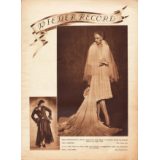
|
Cover of the illustrated Wiener Record Mode no. 104 for July 1929.
[Two large-format fashion photographs:] Elegant wedding gown made of heavy, dull satin; large train with lustrous bow. Tight-fitting bonnet made of white pearls. Model: LEBOUVIER. Phot. D'ORA, Paris.
On the left: Elegant ensemble of blue taffeta, wide tulle edges sewn with taffeta ribbons; small straw hat with veil. Model: A. GALLEWSKI. Phot. BALAZS, Berlin.
Photos: Madame d'Ora (Dora Kallmus or Dora Philippine Kallmus, 1881-1963); studio Alexander Balázs, Berlin (1890-1932).
[Page 3]
|
|
P. 4 |

|
Article:
Falk, Henry, In the Overland Bus (by Henry Falk, unknown author; translation into German by Rose Richter).
[Three fashion photographs]
Center: Large rubber animal — a popular water toy for young and old. Phot. BECKER & MAASS, Berlin. *
Left: Open-air suit, consisting of a two-piece leotard and short coat. Model: WORTH. Photograph. D'ORA, Paris. *
Right: Bathing pajamas made of raw linen with red trim; large red and white checked parasol. Model: HERMES. Phot. D'ORA, Paris.
Photo: studio Becker & Maass, Berlin; Madame d'Ora (Dora Kallmus or Dora Philippine Kallmus, 1881-1963).
[Falk, Henry, In the Overland Bus.]
Like a dragon with flaming eyes, the bus comes racing through the mountain twilight, stops in front of the hotel and spits out the passengers it has devoured during the day, unharmed. Some emerge from its mouth, others from large wounds on the monster's flanks, which small grooms close with little doors. Night falls quickly on this beautiful day and the shadows of the mountains grow longer. The driver of the empty car has sat down next to the chauffeur, who still has to park the car in the garage of the Alpine Club.
"Ready, Mr. Emile, it's almost eight o'clock. Let's go and have supper."
Bastien was a strapping fellow from the local area, with a thick shock of red hair, a low forehead and small, round eyes, who had been driving the car for a year.
"Yes, it's time," confirmed Emile, who had already been showing the passengers the splendors listed in the travel guide for a year. Emile — brown hair, high forehead, glasses on his nose — is a city dweller who, in a rare case, preferred nature to the city. As the son of a civil servant, he had also been destined for a career in the bureaucracy when he was sentenced to a long stay at a high altitude for health reasons and, in order to earn some money, took the job of a tour guide at the overland bus. Enviable the excursionists, if they need someone to dictate their impressions, to meet this talkative, enthusiastic guide. When Mr. Emile sat down opposite the good Bastien in the inn, where the evening soup was already steaming towards them, he sighed with a look of lamentation:
"Oh yes! Another adventure! But a real adventure, my boy: a young blonde girl! She listened to me with her mouth open… — she just melted — I thought I could hear her heart beating! Did you see her?"
"No. I had my eyes on the valance. But if you think a girl with such an expensive round-trip ticket would even look at you, then you're not right in the head."
"You pathetic earth worm. Shall I tell you something else? She spoke to me when I got off — and guess what she told me!"
"There's your forty sous tip."
"Poor fool! She told me: 'My friend' — you hear: … [continued on next page 5].
[Page 4]
|
|
P. 5 |
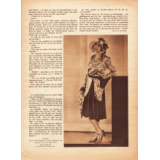
|
Article:
Falk, Henry, In the Overland Bus (by Henry Falk, unknown author; translation into German by Rose Richter).
[Large-format fashion photography]
RIGHT: Distinctive afternoon dress made of colorful Chinese crepe and black crepe satin (Maria West [or Maria Crone (also: Crone-West), Austrian actress, 1900-1990]). Model: DRÉCOLL. Phot. BECKER & MAASS, Berlin.
Photo: studio Becker & Maass, Berlin.
[Falk, Henry, In the Overland Bus.]
[Continued from previous page 4] … my friend! 'You have made me so aware of the beauties of nature today that I will make the same trip again tomorrow. 'Reserve me the seat next to you!"
"Perhaps she is hard of hearing."
"Cretin!"
Emile was trembling with rage. After a long, dogged silence, while Bastien calmly diced beef and cucumbers on his plate, he burst out: "Shall I give you a piece of my mind? You seem like an animal to me, not a human being: limited, ignorant, primitive. Oh, how paradoxical and yet true! 'A child of the mountains', born at the foot of the glacier majesty — and you have never even noticed its beauty and greatness."
"Yes, you know, my dear, I'm just looking at the path."
"Tell me, how do you feel, for example, when we drive through the Paravese valley?"
"Jolts."
"In your heart?"
"No, somewhere else entirely. The road there is miserable."
"A monster! But the Paravese valley is of overwhelming beauty! Oh, how the beautiful blonde there soaked up my every word: 'Can you see the rainbow-colored little waterfalls with their lace fringes above the rocks and those delicate mountain peaks on which the sun paints the blue glaciers pink? Isn't that wonderful!"
"Really?" said Bastien, and stopped chewing for a moment. "Is it really that beautiful?"
"Oh, if I could only lift you a little above yourself! — But good night for the present! Tomorrow!"
Emile slammed the door behind him, leaving Bastien silent and lost in thought.
*
The next morning the blonde girl was among the passengers:
"You see that she has come, you silly fellow!" whispered the guide triumphantly to the chauffeur. "But for that I shall be of an unheard-of eloquence, and of a poetry —!"
The round trip began and Bastien at the wheel thought: "Stupid guy!" He was probably right. I roll and roll along roads like a machine — more numb than my 50 horsepower — and I see nothing, nothing — nothing at all — of everything that is admired around me.
They had arrived in the Paravese valley and Emile began to declaim: "Ladies and gentlemen! Can you see the rainbow-colored little waterfalls above the rocks — those mountain peaks where the sun paints the blue glaciers pink? Isn't that wonderful?"
"Yes!" the driver Bastien suddenly shouted, looking around, "it's wonderful!"
A second later, the bus was in the ditch — which fortunately wasn't deep. Abrasions, bruised arms, black and blue marks, nothing serious. — But all the day-trippers were screaming bloody murder about the driver. The young, blonde girl, limping, regretted having come along again. Emile, with a cut nose, howled. Only Bastien was sitting on the grass, unharmed and unconcerned about the wailing; he looked at nature for the first time in his life and could not contain his admiration: "Wonderful! Marvelous! Simply marvelous!" (German by Rose Richter.)
[Page 5]
|
|
P. 6 |
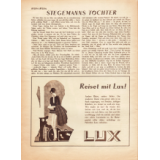
|
Article:
Roda, Roda, Stegemann's Daughters (by Alexander Friedrich Ladislaus Roda Roda, 1872-1945).
[Roda, Roda, Stegemann's Daughters.]
He had four of them, ranging in age from sixteen to twenty-four, plus a very young one who was only eight years old — all big, beautiful girls — but girls, no son and, what was more unfortunate, no son-in-law.
One day, at the beginning of June, there was an uproar in the girls' room. Mom was quarreling, the daughters were crying and laughing, Dad had retreated.
And the reason? Uncle Peter had invited all five siblings over. Yes, he dared to do that. He has no daughters, the lucky man, thought Mr. Stegemann, and doesn't know what he's doing.
A week later, a train compartment was filled with Stegemann's daughters — Mila, Luise, Flora, Nelli, Emma departed cheering and chattering — a company of girls in gray-red uniforms.
Uncle Peter took them in well, aunt and cousin behaved in an exemplary manner. They followed the principle of hospitality: to let the guests entertain themselves as they pleased.
Five weeks passed. Then five letters fluttered out into the world from Uncle Peter's estate.
Mila, the eldest, was the first to fulfill her duty as a friend. She wrote: "Dear Kaethe! So here I am, in the country, as I had so terribly wished. I could give you a long description, but we have always thought it would be better to keep it short and sweet. Let me tell you in catchwords: Wonderful rides — elegant horses, drive them yourself — immensely gallant cousin — splendid eyes — laughing mouth full of white teeth — terrible palpitations in some moments — on both sides, if I am not mistaken. — Now you know everything. Let me tell you just one more thing: I recently drove into the woods. How terribly romantic and interesting such lonely drives are! I'm daydreaming — then a hunting dog jumps out of the bushes and barks around the carriage. One of the horses bolts — I scream — I think I even dropped the reins in fright. Someone grabs the reins of the horses and brings them to a halt. My rescuer is called Arno Meier and is a friend of cousin Gerhard. Of course, he's not as handsome as Gero. But just think: a man called Arno! Don't you have to forgive him everything, even his family name? Oh, if only my name were Countess Falkenfels and there were a law that husbands take the name of their wives on their wedding day! But even then, this Arno would not be my cup of tea. Next to Gero — I can't help it — he shrinks to a zero. Gero is the only one. Please don't call me immodest, but I believe that I'm really not indifferent to Gero. Greetings and kisses — Mila."
One afternoon, Luise also tore herself away from her favorite pastimes and wrote the following letter: "Dear Leotine! I wish you all the best for your birthday. I hope you are as well as I am. I have become very attached to my aunt, work hard and feel like I belong to the house. My dearest Leotine, sometimes when I fetch cream, sweet, unadulterated cream from the milk cellar, a pair of dark eyes follows me: Gerhard's eyes. And in those eyes lies the wish that it would stay like this forever, that I could fetch cream for my cousin forever, and that he would look after me like this forever. Yes, Leotine, that would be bliss! But someone else is interested in me: the director of the neighboring estate. Not an old man. He's in his forties, Mr. Eduard Koelner, very nice. He can't be next to Gerhard. … [continued on page 8].
Advertising:
Travel with Lux! Other places, other pictures. The modern lady likes to travel; she is always smartly dressed, with fresh, filmy clothes, wherever she may be. How does she do it? She washes her clothes with Lux and, because she always has Lux with her, she is independent of time and place. And how easy and safe such a Lux wash is; your luggage should therefore definitely contain a packet of Lux. LUX. Drawing/illustration: unknown/unsigned.
[Page 6]
|
|
P. 7 |
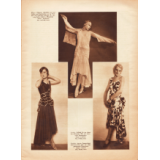
|
[Three fashion photographs]
Center: Elegant evening dress of pink chiffon with rhinestone embroidery; fabric ends are attached to the necklace, falling like a cape (Edith v. Winterfeld [Baroness Edith von Winterfeld, biographical data unknown]). Model: HERPICH. Phot. BALAZS, Berlin.
Left: Robe de style for the evening in black tulle with elaborate rhinestone embroidery. Model: LANVIN. Phot. D'ORA, Paris.
Right: Distinctive summer evening dress in crepe satin with a beautifully drawn rose pattern. Model: GOUPY. Phot. D'ORA, Paris.
Photos: studio Alexander Balázs, Berlin (1890-1932); Madame d'Ora (Dora Kallmus or Dora Philippine Kallmus, 1881-1963).
[Page 7]
|
|
P. 8 |
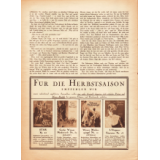
|
Article:
Roda, Roda, Stegemann's Daughters (by Alexander Friedrich Ladislaus Roda Roda, 1872-1945).
[Roda, Roda, Stegemann's Daughters.]
[Continued from page 6] … Hovering between two loves like that! Recently he passed me, Eduard, tipped his hat and said: "Good day, Miss Luise!" — in a tone, I tell you, that penetrated my heart. And yet my love belongs to Gerhard and his heart — I hope — to me. It embraces you most tenderly. Your overflowingly happy Luise."
She had her head bent low on the table, pen at the ready, young Flora, staring at her writing paper for half an hour, chasing after a thought that could not be hashed out. At last she looked up at her sister Mila. "What else should I write to her?"
"What you haven't written to her yet."
"Ah — you! Listen to me:
'Beloved Paula! You're asking how I'm doing? I'm doing very well here. It's a great pleasure to go for a walk, the garden is very beautiful and adorned with many fragrant flowers. I have already pressed a lot.' — That's how far I've come, but further?"
Mila got up to go away. "Write to her," she said in the doorway, "that you are madly in love with Gerhard — and a long, long story about birds and bees, May air and love!" — Mila closed the door, laughing.
Flora threw the letter she had started into the corner as a big lump of paper. Had that Mila been spying again and discovered poor Flora's diary! Bright tears of anger stood in her eyes.
The fourth letter: "Dearest Fini! Think of yourself! Heart! Friend! Mouse! Fini, no, you can't think it, so let me tell you. I haven't written to you for four weeks. Do you know why? Because I've been unhappy in love. Today I'm suddenly writing to you. Do you know why? Because I'm happily in love. You, poor child, have never experienced anything like it, you are two months younger than me. You know that I always sigh under the burden of my older sisters, and this is no exception. I was the little young miss and was always supposed to play with Emma, while the three of them, Mila, Luise and the highly poetic Flora, coquettishly flirted with Gerhard, with Gerhard, whom I myself loved so unspeakably. Yesterday, when we were alone in the pavilion, he suddenly confessed his feelings to me. I had thought such an explanation would be more complicated. He didn't struggle for breath, he didn't even brush his hair nervously. He simply took me in his arms, kissed me firmly and asked me if I wanted to be his wife. — 'Of course I would,' I said. 'If I'm small, it won't hurt, I'll grow. I cheer and shout. The young miss becomes a woman in the blink of an eye. Yay! Congratulations quickly, so you can be the first! Mila, Luise and Flora will be green and yellow with envy. Your Nelli."
The time also came for little Emma. She used half a liter of ink, more for staining the hallway, dress and apron than for writing, a huge amount of letter paper, drew letters for half a day and finished ten lines: [in original German text with spelling errors of a young child:] "Dear Elsa! I am very happy to be with my uncle. Auntie is very good, I won't write much to you because you haven't written to me yet either. I'm sewing my doll a dress, pink with red ribbons, which Auntie gave me. Now I have more peace from Mila and Luise and Neli. I never put up with anything from stupid Flora! They're all silly geese. But don't tell anyone, burn the letter! Emma."
The sisters stayed for another four weeks and slowly recovered from Gerhard's disloyalty.
They denied any interest in their future brother-in-law to Nelli. And to prove it clearly, they fell in love elsewhere.
Only one thing clouded their joy: the fact that the stork had brought them a sixth baby sister at home.
Advertising:
[Self-promotion of the publisher Société Graphique, Aktiengesellschaft fuer Modeverlag (stock company for fashion publishing), Vienna XVIII.] FOR THE FALL SEASON WE RECOMMEND our seasonal albums listed below, which contain a rich selection of elegant, yet simple Parisian and Viennese models of all women's and children's fashions.
STAR no. 23, the most popular seasonal album; contains around 500 elegant models in a magnificent cover, 52 pages on art paper, 20 of which are printed in artistic color.
Grosse Wiener Modenwelt [Great Viennese Fashion World] no. 30 (SMART). Large seasonal album, indispensable for every fashion artist's workshop. The journal contains 44 pages in a splendid cover, 20 of which are printed in artistic color; approximately 400 models.
Wiener Modenspiegel [Viennese Fashion Review] no. 10 (STELLA). Rich seasonal album with 52 pages, 12 of which are printed in color. 400 simple and easy-to-execute models of the entire women's and children's fashion.
L'Elégance Feminine [Feminine Elegance] no. 18, a new seasonal album with 16 pages in color and 16 pages in black print containing around 300 models in artistic pen and ink drawings. The album is produced entirely on the finest art paper!
[Page 8]
|
|
P. 9 |
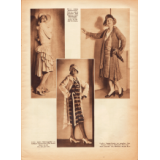
|
[Three fashion photographs]
Left: A beautiful afternoon dress made of light blue crepe de chine (Viola Garden [Austrian silent film actress, 1902-1993]). Model: KLYHS. Phot. BALAZS, Berlin.
Center: Chic summer ensemble: Dress of white and red patterned silk, coat of white wool georgette (Viola Garden). Model: KLYHS. Photograph. YVA, Berlin.
Right: Summer ensemble of spotted crepe georgette. Black horsehair hat (Grita Ley [or Gritta Ley, German actress, 1898-1986]). Model: BECKER. Phot. BECKER & MAASS, Berlin.
Photos: studio Alexander Balázs, Berlin (1890-1932); "Yva" or Else Ernestine Neulaender-Simon (1900-1942); studio Becker & Maass, Berlin.
[Page 9]
|
|
P. 10 |
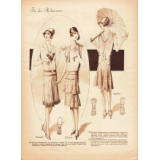
|
For Mid-Summer.
3668. Simple midsummer dress made from natural-colored raw silk. The shaped skirt section is finely pleated. Skirt hem, double belt and novel jabot made of red raw silk. (Raw silk 3.50 m by 80 cm wide, raw silk 1 m by 80 cm wide.) Pattern size 44.
3669. Sleeveless midsummer dress for the hottest days made of beige crepe de chine with a colorful pattern. Basic skirt and flounce form bells that protrude strongly at the sides. Pleated ruffles serve as a finishing touch. Wide belt made of silk ribbon. (Fabric usage: 3.25 m by 100 cm wide.) Pattern size 44.
3670. Filmy midsummer dress in colorful floral "crêpe-mousseline" [crepe muslin]. The bodice continues as a rounded hip yoke. Collar and jabot made of white muslin. (Printed crepe mousseline 2.75 m by 100 cm wide, crepe georgette 0.50 m by 100 cm wide). Pattern size 44.
[Page 10]
|



